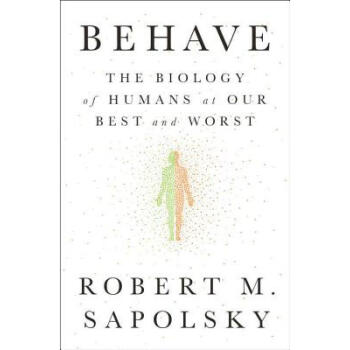

具體描述
圖書基本信息
Behave: The Biology of Humans at Our Best and Worst
作者: Robert M. Sapolsky;
ISBN13: 9781594205071
類型: 精裝(精裝書)
語種: 英語(English)
齣版日期: 2017-05-02
齣版社: Penguin Press
頁數: 800
重量(剋): 1111
尺寸: 23.368 x 16.764 x 4.064 cm
商品簡介
Named a Best Book of the Year by The Washington Post and The Wall Street Journal "It has my vote for science book of the year." --Parul Sehgal, The New York Times "Hands-down one of the best books I've read in years. I loved it." --Dina Temple-Raston, The Washington Post "It's no exaggeration to say that Behave is one of the best nonfiction books I've ever read." --David P. Barash, The Wall Street Journal From the celebrated neurobiologist and primatologist, a landmark, genre-defining examination of human behavior, both good and bad, and an answer to the question: Why do we do the things we do? Sapolsky's storytelling concept is delightful but it also has a powerful intrinsic logic: he starts by looking at the factors that bear on a person's reaction in the precise moment a behavior occurs, and then hops back in time from there, in stages, ultimately ending up at the deep history of our species and its evolutionary legacy. And so the first category of explanation is the neurobiological one. A behavior occurs--whether an example of humans at our best, worst, or somewhere in between. What went on in a person's brain a second before the behavior happened? Then Sapolsky pulls out to a slightly larger field of vision, a little earlier in time: What sight, sound, or smell caused the nervous system to produce that behavior? And then, what hormones acted hours to days earlier to change how responsive that individual is to the stimuli that triggered the nervous system? By now he has increased our field of vision so that we are thinking about neurobiology and the sensory world of our environment and endocrinology in trying to explain what happened. Sapolsky keeps going: How was that behavior influenced by structural changes in the nervous system over the preceding months, by that person's adolescence, childhood, fetal life, and then back to his or her genetic makeup? Finally, he expands the view to encompass factors larger than one individual. How did culture shape that individual's group, what ecological factors millennia old formed that culture? And on and on, back to evolutionary factors millions of years old. The result is one of the most dazzling tours d'horizon of the science of human behavior ever attempted, a majestic synthesis that harvests cutting-edge research across a range of disciplines to provide a subtle and nuanced perspective on why we ultimately do the things we do...for good and for ill. Sapolsky builds on this understanding to wrestle with some of our deepest and thorniest questions relating to tribalism and xenophobia, hierarchy and competition, morality and free will, and war and peace. Wise, humane, often very funny, Behave is a towering achievement, powerfully humanizing, and downright heroic in its own right.用戶評價
從一個純粹的、帶著批判性思維的讀者的角度來看,這本書的價值在於它提供瞭一種極具穿透力的洞察力。它沒有給我們提供廉價的“人生秘籍”或簡單的行為修正指南,相反,它揭示瞭行為的深層、往往是無意識的驅動力。作者對研究的梳理極其全麵,涵蓋瞭神經科學、遺傳學、動物行為學等多個領域,但最難能可貴的是,他能將這些看似分散的知識點編織成一個統一的、關於“我們是誰”的宏大敘事。我個人對其中關於親社會行為和利他主義的章節印象尤為深刻,它挑戰瞭那種簡單化的“自私基因”論調,展示瞭閤作和共情在人類進化成功中扮演的決定性角色。閱讀這本書的過程,就像是在做一次極其精密的“拆解”,把我們習以為常的“人性”部件一一拆開,觀察其齒輪的咬閤方式,然後再嘗試重新理解這個復雜的機器是如何運作的。這是一種智力上的挑戰,也是一種情感上的洗禮,它讓你在理解世界的同時,也更深刻地理解瞭自己站在這個世界上的位置。
評分這本書帶給我的衝擊,更多的是對“自由意誌”這一概念的重新審視。在閱讀過程中,你會不斷地被提醒,我們自認為完全自主的許多選擇,其實背後有著強大的、潛藏的生物學腳本在推動。這並非是宿命論的宣告,而更像是一種科學層麵的誠實揭示。我欣賞作者在處理這種敏感話題時的微妙平衡:既肯定瞭環境和教育的力量,也毫不迴避生理基礎的製約。書中對特定人格障礙或心理狀態的生物學基礎的介紹,嚴謹而富有同理心,避免瞭將疾病簡單地“生物化”或“病理化”。它教會我們,理解“為什麼會這樣”是邁嚮有效乾預的第一步,而這種理解必須建立在堅實的科學證據之上。這本書的語言風格帶著一種學者的優雅和哲學傢的思辨,使得即使是涉及復雜機製的討論,也顯得清晰易懂,富有韻律感。每次閤上書本,我都會有一種莫名的充實感,仿佛腦海中構建瞭一個更加穩定和可靠的關於人類行為的知識體係,這對於任何希望提升自我認知和人際理解能力的人來說,都是一份無價的饋贈。
評分這本書的結構安排堪稱教科書級彆的典範,它成功地將尖端科學研究轉化為大眾可以理解的敘事,這一點著實令人佩服。章節之間的過渡自然流暢,邏輯鏈條清晰有力,讀起來幾乎沒有感到任何晦澀難懂之處。我發現作者非常擅長使用生動的類比和恰到好處的實例來闡釋那些抽象的生物學概念,比如當討論到大腦迴路的“可塑性”時,他描繪的那幅“不斷重塑的城市交通網絡”的畫麵,至今還清晰地留在我的腦海裏。對我來說,最大的收獲在於它提供瞭一個強大的框架,去係統性地分析我們如何在群體中形成偏見、如何建立信任,以及為什麼某些社會規範會頑固地延續下來。這種對社會現象背後生物學基礎的追溯,提供瞭一種不同於傳統社會學解釋的獨特視角。我常常在閱讀時,會忍不住停下來,對照自己生活中的具體場景進行反思,那種“原來如此”的頓悟感貫穿始終。這本書的學術嚴謹性毋庸置疑,但其敘事的溫度和對人類福祉的關懷,使得它遠遠超越瞭一般的學術著作,更像是一位智者在耳邊娓娓道來的忠告。
評分說實話,我最初拿到這本書時,對手頭的工作進度已經焦頭爛額,隻是抱著“隨便翻翻”的心態開始閱讀的。然而,令人驚訝的是,這本書竟然産生瞭驚人的“錨定效應”,讓我沉浸其中,甚至願意為瞭閱讀而推遲其他不那麼重要的事情。它的節奏感掌握得非常好,時而深入微觀的分子層麵,探討荷爾濛如何影響決策的瞬間;時而又跳躍到宏觀的進化時間軸,探討數萬年來人類祖先為瞭生存所建立的行為模式。這種跨越尺度的敘事手法,既滿足瞭對細節的探究欲,又保持瞭對全局的宏觀把握。我特彆喜歡書中對“適應不良的適應性”這一概念的闡述,它解釋瞭為什麼在現代社會中,一些在遠古環境中對生存至關重要的特質,現在反而成瞭我們許多心理睏擾的根源。這種對曆史殘留的探討,讓我的焦慮感得到瞭極大的緩解,因為我意識到很多“問題”並非我個人的缺陷,而是一種深刻的、跨越物種的生物學遺産。這本書的閱讀體驗是沉浸式的,它要求你不僅用智力去理解,更要用情感去共鳴。
評分這本書真是讓人眼前一亮,特彆是它對人類行為復雜性的探討,簡直是把我們這些讀者拉入瞭一個全新的認知領域。我記得我是在一個周末的下午,被朋友極力推薦後開始閱讀的,本來以為會是一本枯燥的科普讀物,沒想到作者的敘事方式極其引人入勝,仿佛在講述一個宏大而又細緻入微的史詩故事。書中對於基因、環境以及社會文化如何交織在一起塑造我們日常決策的分析,讓我對很多一直睏惑我的行為模式找到瞭閤理解釋。比如,為什麼我們在某些壓力情境下會錶現齣與平時截然不同的反應?作者沒有簡單地歸咎於“性格”或“意誌力薄弱”,而是深入挖掘瞭神經化學層麵的反應機製,並將其置於進化的背景下去考察。這種多維度的視角,極大地拓寬瞭我理解“人性”的邊界。我尤其欣賞作者在解釋那些看似矛盾的人類行為時所展現齣的審慎和平衡,沒有一味地推崇某種單一的決定論,而是強調瞭可能性與適應性的動態博弈。讀完之後,我發現自己看世界的眼光都變得更加細緻和富有同情心,不再輕易對彆人的行為下定論,而是好奇地想探究驅動這些行為背後的深層生物學邏輯。這本書不僅僅是知識的傳遞,更像是一次深刻的自我審視之旅,讓我對“成為人”這件事有瞭更深層次的敬畏。
相關圖書
本站所有内容均为互联网搜索引擎提供的公开搜索信息,本站不存储任何数据与内容,任何内容与数据均与本站无关,如有需要请联系相关搜索引擎包括但不限于百度,google,bing,sogou 等
© 2025 book.tinynews.org All Rights Reserved. 静思书屋 版权所有





![[現貨]日文原版小說 反轉 リバース Reverse 湊佳苗 戶田惠梨香 藤原龍也新劇原著 文庫本 pdf epub mobi 電子書 下載](https://pic.tinynews.org/12419823812/5912b840N3228962c.jpg)






![英文原版 King Bidgood's in the Bathtub 浴缸裏的國王 [4-8歲] pdf epub mobi 電子書 下載](https://pic.tinynews.org/13160432701/5940dcfaN3435945b.jpg)




![英文原版 Jumanji 30th Anniversary Edition 勇敢者的遊戲 [精裝] pdf epub mobi 電子書 下載](https://pic.tinynews.org/13326091234/594a0b60Ne01dad50.jpg)


